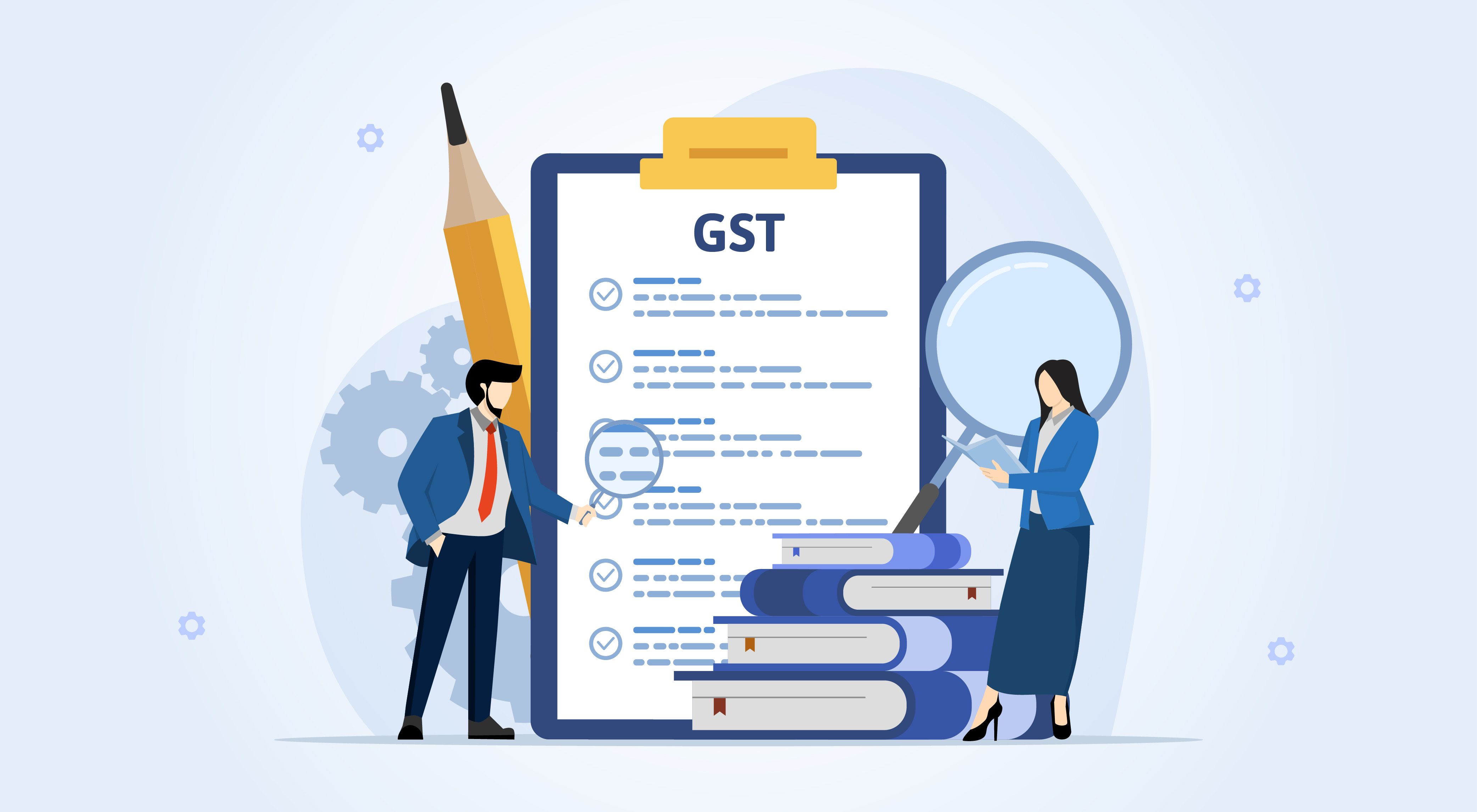The 56th GST Council (3 Sept 2025) revamped the tax slabs into two main rates—18% and 5%—plus a new 40% rate for luxury and demerit goods. Essentials like bread, milk, and many packaged foods now fall under 0–5%, and common items like soaps and shampoos drop to 5%. Luxury goods such as high-end cars, yachts, and soft drinks move to 40%. All individual life and health insurance policies become GST-free. Tobacco items stay at 28% + cess for now.
The new rates apply from 22 September 2025. As per Section 14 of the CGST Act, the rate depends on the time of supply. If any two of these—invoice date, payment date, or supply date—occur before 22 September, the old rate applies; otherwise, the new rate applies.
What is GST Rates?
GST Rates refer to the percentage of tax levied on the supply of goods and services under the Goods and Services Tax (GST) system in India. These rates determine how much tax is added to the price of goods and services. As of the latest reforms in 2025, GST rates are structured into primary slabs of 0% (nil-rated), 5%, 12%, 18%, and 28%, with a special higher rate of 40% applied to luxury and sin goods. Some goods and services may also attract lower special rates like 3% or 0.25%. These rates apply uniformly under Central GST (CGST), State GST (SGST), and Integrated GST (IGST) frameworks depending on intra-state or inter-state transactions. The GST Council, comprising central and state government representatives, regularly reviews and revises these rates based on economic and sectoral needs.
Pre-cutoff preparations (Before 22 September 2025)
- Document trails: Maintain detailed records of prices and invoices before and after 22 September 2025. Although the formal anti-profiteering authority is now sunset, regulators expect full pass-through of tax cuts to consumers. Keep logs or spreadsheets showing pre-change and post-change prices for key SKUs in case authorities seek evidence of benefit transmission.
- Industry impact analysis: Inventory all products/services you sell and note their new GST slab. Compute the net cost impact on each – for example, if an item becomes exempt (0% from 5%), you must reverse its input tax credit. Thus, a 5% rate cut does not mean 5% lower, cost – factor in the ITC reversal need to be considered. Similarly, if your outputs move to a higher rate, plan margin protection or price hikes. Use notifications (Notification No. 09/2025-Central Tax (Rate) dated 17.09.2025) for precise changes, not just Council summaries.
- Systems and ERP updates: Update your finance/ERP systems well before the cut-off. Load new GST rate masters (HSN/SAC) for 5%, 18%, 40% with an “effective from” date of 22 September,2025; keep old rates active through 21 September,2025. Adjust invoice templates with rates according to Time of Supply. Test your e-invoicing/e-way bill integration with the new codes (e.g. generate an IRN on a sandbox with date = 22 September,2025) to catch mapping errors. Plan a system “flag flip” at 00:00 on 22 September,2025 so that any document dated 22 September,2025 automatically uses the new rates. Automate validations to block any invoice dated ≥22 September,2025 carrying an obsolete rate considering the time of supply.
- Pricing, catalogues and schemes: Prepare dual price catalogs/scheme versions (pre- and post-change). Calculate new base prices or MRPs so that after-tax prices reflect the law change. For stock with fixed MRP labels, note that updated labels are not mandatory: original MRP can remain visible. (If you do re-sticker or repack, Legal Metrology allows stickers/online printing of revised prices, provided the old MRP isn’t hidden.) Plan any promotional adjustments so that the rate cut is actually passed to dealers/retailers/consumers.
- Internal training and SOPs: Train sales, accounting and compliance teams on the new rates and processes. Create or update internal SOPs: e.g. an Invoicing Cutoff SOP that defines who “flips” the system rates when, and an MRP Stickering SOP with photographic evidence requirements. Define an exception-handling workflow for any Sec.14 (time-of-supply) mismatches. Document a price-monitoring log to track before/after prices for key products (useful for audit or media queries).
Sales, receivables and contracts
- Open sales orders: Review outstanding sales orders and delivery schedules. If a delivery now falls on/after 22nd September,2025, re-price the tax line using the new GST slab. Maintain consistent base prices if your policy is to fully pass on tax cuts. For orders bridging the date, follow Section 14 of CGST Act,2017: allocate supplies up to 21st September,2017 at old rate, and supplies on/after 22nd September,2017 at new rate.
- Advance receipts: Tag customer advances to contracts or If you invoice after 22nd September,2025 for goods delivered partly before, split the advance proportionally. Tax up to the supply date uses the old rate, balance uses the new rate. Any tax shortfall or surplus (due to rate change) can be adjusted via the final invoice or a credit/debit note, as allowed by CBIC FAQs.
- Contracts and T&Cs: For future agreements, insert a “statutory variation” clause along these lines: “Prices are exclusive of any change in GST rate by time of supply (Section 14 of CGST Act,2017) shall be to the account of the buyer/seller as applicable. The invoiced tax rate will follow Section 14 of CGST Act,2017, and parties agree to issue credit/debit notes to true-up differences.” This ensures a contractual mechanism to adjust for any rate shifts. Also review fixed-price or F.O.B. contracts – you may need addendum clarifying that tax changes will be handled via credit notes.
- Price protection schemes: If you run coupons, rebates or customer discount schemes, adjust them so the new tax rate is reflected in the net Communicate with key customers about how you’ll handle invoicing on the cut-off day to avoid disputes.
Procurement and payables
- Open purchase orders: Identify all purchase orders for goods to be received on/after 22nd September,2025. Inform suppliers of the cut-off date; ask them to invoice you with the new rates (unless their supply was completed before 22nd September,2025). Share your understanding of Section 14 of CGST Act,2017 with vendors: if goods were dispatched/received before midnight on 21st September,2025, old rates apply. Get written confirmation from suppliers on the rate used for each invoice.
- Advance payments to vendors: If you paid advances before 22nd September,2025 but receive goods/invoices after, split the advance as “old rate / new rate” based on supply date. The supplier’s invoice should reflect this split (they can issue an invoice showing part supply with old rate, part with new). Reconcile any balance via credit or debit notes with the supplier.
- Construction and projects: For works contracts or construction BOQs, map milestones to dates. GST on materials like cement dropped to 18% (from 28%), but the service portion of works contracts has gone up to 18% (from 12%). For any certificate or milestone achieved before 22nd September,2025, apply the old rate; for later milestones, apply 18%. Maintain measurement books, completion certificates and invoices as evidence of timing.
Inventory, returns and in-transit goods
- MRP-labelled stock (pre-packed goods): You may apply stickers or online prints to show the new (lower) MRP, but it is not mandatory. Legal Metrology permits unsold goods with old MRP made before 22nd September,2025 to be sold unchanged; manufacturers can voluntarily add revised-price stickers as long as the original price remains Use up printed labels gradually or re sticker after 22nd September,2025; unused pre-printed packs with old MRP can be used until March 2026 or stock-out, with new MRP stamped/printed.
- Goods in transit: Determine the supply date by contract terms or receipt documents (LR, GRN). If title passed to buyer or service was performed before midnight of 21st September,2025, apply the old GST rate; if it occurs on/after 22nd September,2025, use the new rate. Retain transport docs and delivery acknowledgments to substantiate the timing under Incoterms.
- Sales/purchase returns: If a customer returns goods after 22nd September,2025 against an invoice issued before the change, issue a credit note with the original (old) rate. Similarly, for vendor credit memos, ensure the GST on the credit matches the original purchase Follow the same timeline for filing these credit notes as for normal invoices.
Documentation and communication
- Customer/dealer circular: Prepare a clear notice explaining the 22nd September,2025 rate changes, your price/pass-through policy, and how you will handle transitional cases (e.g. straddled orders, returns). Attach a one-page summary of Section 14 of CGST Act,2017 State explicitly that your MRPs/prices have been updated to reflect tax cuts. Instruct retail channels not to charge above the revised consumer price.
- Vendor communication: Send a letter or email to all key suppliers with the effective date reminder. Emphasize that invoices must reflect the supply date (time of supply) for tax Consider including a short guide or flowchart on Section 14 of CGST Act,2017 (similar to CBIC FAQs) so vendors know when to use old vs new rates. Also update your purchase order templates (or issue PO addendum) noting the statutory variation clause and compliance expectation.
- Terms and Conditions: Update your standard sales T&C to include a GST variation clause as Define “time of supply” in the contract or reference Section 14 of CGST Act,2017 to avoid disputes over split-month transactions. Similarly, revise any price escalation clauses or GST disclaimers to align with the new rate regime.
- Internal SOPs and training: Finalize and circulate internal SOP documents: e.g. Invoicing Cutoff SOP (who switches tax codes, cut-off times), MRP Re stickering SOP, and Section 14 of CGST Act,2017 Exception SOP (workflow for overrides). Train sales staff and procurement staff on new processes. Schedule refresher training just before 22nd September,2025 so team members remember to apply old rates only up to 21st September,2025 and follow the new rules from the 22nd September,2025.
Pricing and market strategy
- Pass-on expectation: Government leaders have explicitly urged full benefit pass-through. Commerce Minister Piyush Goyal asked industry to pass “every single rupee” of GST savings to consumers. The Finance Ministry is closely monitoring prices to ensure cuts reach buyers. In highly competitive sectors (FMCG, autos, consumer durables, ), failing to reduce retail prices risks loss of demand and market share. Where practical, adjust MRPs down by roughly the tax- difference percentage or offer extra quantity/discount promotions to reflect the GST cut. Keep marketing teams ready to communicate these consumer benefits (e.g. “Now even cheaper, thanks to GST cuts”).
- Margin vs. volume: In some cases, businesses may choose not to reduce prices fully (preserve margin) when input costs fell but end-consumers have ITC (B2B sales) or where inventory costs can offset cuts. Still, transparency is key. Document the rationale if you cannot pass full benefit. For inputs that became cheaper (e.g. cheaper raw materials), consider passing savings to your buyers to stay competitive – especially if competitors will cut prices. Conversely, if your output tax increased (e.g. a service went from 12% to 18%), plan to raise selling prices accordingly (or at least communicate early with clients). The guiding principle is that the net price to the consumer should ideally fall by approximately the tax-cut percentage.
- Non-ITC sectors: Certain segments like standalone restaurants, salons or gyms have lost some input credits (e.g. salons moved to 5% but lost 18% credit). These businesses should carefully assess whether to pass on the full 13% benefit or only partially (after absorbing higher costs). In any event, they should explain the net effect to customers and adjust service packages sensibly. (For instance, gym memberships or salon service prices can be tweaked so that customers still see a benefit while business input costs remain covered.)
Day-of Cutover (22 September,2025) Actions
- System switch: Ensure at midnight (or branch open) the old rates are deactivated and the new rates enforced. Check that all POS terminals, billing software and online portals now default to the revised GST Ideally, run a quick batch of dummy invoices/Nominal value Invoice, on 22 September,2025 to confirm no old-rate items slip through. Any invoice dated 22 September,2025 should automatically carry the new tax – block it, considering the effect of section 14 of CGST Act,2017.
- Invoice processing: If goods were supplied on 21 September,2025 or before but invoiced on/after 22 September,2025, apply the old rate in line with Sec. 14 CGST Act,2017 (Time of supply). If your system by mistake applied the new rate in such cases, route the invoice for manual override. Prepare a “Sec 14 exception” report listing any crossed-date transactions; plan credit/debit notes to true-up these to the correct tax. (The CBIC FAQ explicitly states to use Sec. 14 in determining the rate.)
Post-cutoff controls and reconciliation
- Section 14 of CGST Act,2017, Reconciliation: At month-end (e.g. late September 2025), run a report of all invoices/payments where supply and invoicing straddle 22nd September,2025 Verify the rate applied matches the legal outcome (old vs new rate). Issue adjustment credit/debit notes for any Keep this record of Section 14 of CGST Act,2017 corrections on file for compliance purposes.
- Input Tax Credit (ITC) hygiene: Any ITC taken for purchases before 22nd September,2025 remains fully usable after the change (no disqualification). However, for supplies on/after 22 Sept that have become exempt, reverse the associated ITC as For example, if an item went GST-free after 22nd September,2025, credits claimed on that item’s inputs must be reversed. Reconcile your books vs GSTR-2B/GSTR-3B carefully for September,2025 to ensure no over- claimed credit.
- MRP proof and audit trail: For transparency, archive evidence of new pricing (e.g. photos of re-stickered MRP labels, screenshots of updated price lists, dealer communications). Keep a file of dealers’ acknowledgments or internal notes showing that new rates were passed Although formal anti-profiteering proceedings ended, the government will scrutinize price lists, so a clear audit trail is essential. Each of the above requires specific action. In all cases, communicate early with your customers and vendors about how GST changes will affect pricing. Consistency and transparency will help maintain trust.
Final Steps and Compliance
In summary, use the next few days to test and document everything. By cut-off, your systems should be locked to the new rates, all teams briefed, and communications sent out. After 22nd September,2025, reconcile promptly – run exception reports, compare GSTR-2B vs books, and adjust with credit notes as needed. The goal is full compliance and competitiveness: with every tax cut, consumers should see a corresponding price reduction. The government’s message is clear – ensure the benefits flow through. Maintaining detailed trails of your price adjustments and credit notes will demonstrate good faith if any queries arise.
Most Asked Questions
How should businesses update their billing and invoicing systems before the GST rate change?
Businesses must update GST master data including new GST rates and HSN codes with the effective date. Invoice templates should be adjusted to apply rates based on the “time of supply.” Systems should be tested for e-invoicing and e-way bill integration with new rates before go-live to avoid errors.
What departments within a company must coordinate during a GST rate cutover?
Coordination between finance, sales, procurement, IT, and compliance teams is critical. Procurement should communicate cut-off dates to suppliers. IT should update ERP or billing software. Finance and compliance must ensure correct reporting and audit trails. Sales must manage invoicing and customer communications.
How does the GST rate change affect ongoing contracts and long-term agreements?
GST applies based on the time of supply, which considers invoice date, payment date, and supply date. If goods/services are supplied before the cut-off but invoiced or paid after, GST on the new rate may apply per Section 14 of CGST Act. Contracts may require amendments for tax escalation or pass-through clauses to reflect new GST rates.
What steps should businesses take to update product pricing ahead of the cutover date?
Recalculate Maximum Retail Prices (MRP) to reflect new GST rates ensuring transparency and compliance. Display both old and new prices clearly. Publicize price changes through advertisements. Adjust only for the GST differential to avoid overcharging.
How do businesses handle orders placed before the cutover but delivered after the new rates apply?
GST rate applicable is determined by the time of supply rules. Generally, if payment or invoice is after cutover, new GST rates apply even if order was placed earlier. Proper documentation and communication with customers and suppliers is necessary.
What internal controls are necessary to avoid mismatches in GST reporting post-cutover?
Implement compliance calendars with clear deadlines and responsibilities. Regular internal audits, reconciliation of invoices, and coordination with vendors to ensure accurate GST filings help prevent mismatches.
How should companies manage credit notes and debit notes during the GST transition period?
Credit/debit notes must be reported correctly in GST returns, adjusted for old vs. new rates based on timing. Maintain detailed records showing original and corrected invoices, GSTINs, and related documentation.
Which business records should be maintained to prove compliance during a GST rate revision?
Retain invoices, purchase orders, payment records, credit/debit notes, pricing revision notifications, GST payment challans, and communication logs with vendors and customers.
How can ERP or accounting software be configured to smoothly adopt the new GST rates?
Update tax masters, item masters, and pricing modules with new GST rates effective from the cutover date. Run test transactions to validate calculations, and integrate with updated e-invoice and e-way bill systems. Automate compliance reporting where possible.
What common errors occur during GST rate transitions and how can businesses avoid them?
Common errors include applying old rates post-cutover, incorrect time of supply interpretation, failure to adjust pricing/MRP, mismatched invoices, and incomplete vendor communications. Businesses should ensure thorough training, process updates, and robust internal audits to minimize errors.















